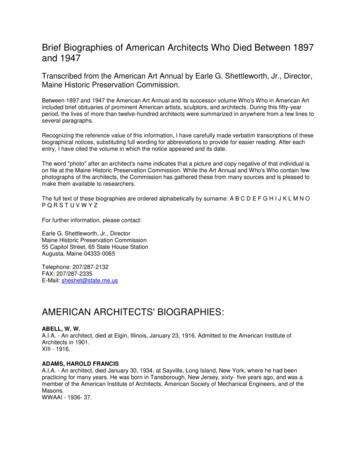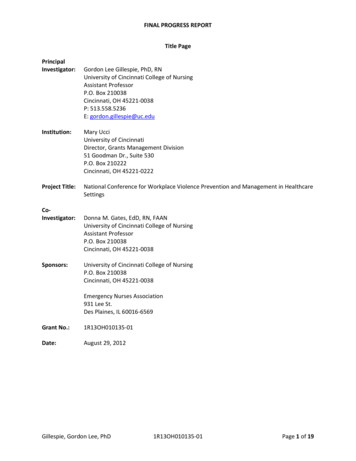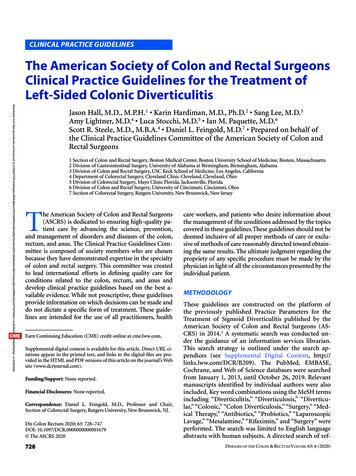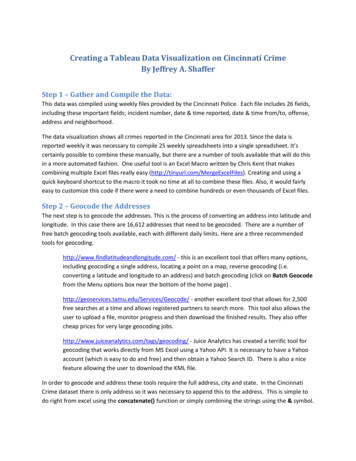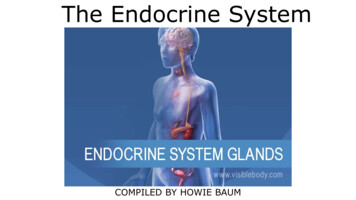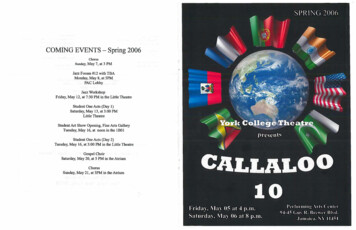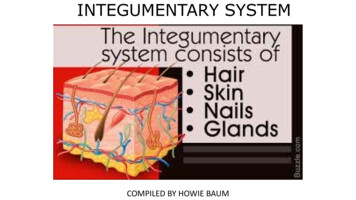
Transcription
INTEGUMENTARY SYSTEMCOMPILED BY HOWIE BAUM
THE SKINThis extraordinary organsystem : Protects the internalstructures of the bodyfrom damage Prevents dehydration Stores fat Produces vitamins andhormones. Helps to maintainhomeostasis within thebody by assisting with theregulation of bodytemperature and waterbalance. It is the body's first lineof defense againstbacteria, viruses, andother pathogens. It helps to provideprotection from harmfulultraviolet radiation. The skin is a sensoryorgan with receptors fordetecting heat and cold,touch, pressure, and pain. The natural secretion ofsebum from the millionsof sebaceous glands, eachassociated with a hairfollicle, is slightly oily andfurnishes the skin withpartially water-repellentand antibiotic qualities.
TOGETHER, SKIN, HAIR, AND NAILS ARE KNOWN AS THEINTEGUMENTARY SYSTEM. The skin is the largest organ in the body, weighing 6–9 pounds and with a surface areaof almost 21 square feet. Its thickness varies from about 1/50 inch on delicate areas such as the eyelids, to 1/5inch or more on areas of wear and tear, such as the soles of the feet. Few body parts renew as rapidly as the skin. Every month the outer layer of epidermis is completely replaced, at a rate of 30,000flake-like dead cells every minute. The journey from epidermal base to surface takes about four weeks, and a typicalperson sheds more than 1 pound of skin every year !! Dead skin cells combine with other particles to create household dust. The averagehome in the United States collects 40 pounds of dust each year !!
Skin has two mainstructural layers.The outer Epidermis is chieflyprotective, and the underlying Dermiscontains many different tissues withvaried functions.The Dermis contains thousands ofmicrosensors that enable the sense oftouch, as well as sweat glands andadjustable blood vessels that contributeto body temperature regulation.Under the dermis is a layer, sometimesregarded as part of the skin, called theHypodermis and is made ofsubcutaneous fat.This layer acts as a buffer and providesextra thermal insulation against extremeheat and cold.
DermatomesA dermatome is a region orzone of skin supplied by thedorsal (rear, sensory) nerveroots of one pair of spinalnerves.The nerve branches carrysensory information abouttouch, pressure, heat, cold, andpain from the skinmicrosensors within the zone,along the sensory nerve fibersof the branches of the spinalnerve, to the spinal nerve rootand then into the spinal cord.A “skin map” delineates theseskin zones, or dermatomes.In real life, the distribution ofnerve roots, and so ofsensations, overlaps slightly.
A patch of skin about the sizeof a fingernail contains5,000,000 (5 million)microscopic cells of at least adozen main kinds:100 sweat glands and theirpores1,000 touch sensors100-plus hairs with theirsebaceous glandsUp to 3-1/3 feet of tiny bloodvessels and about 1-2/3 feetof nerve fibers.
Meissner’s corpuscle Encapsulatednerve ending in the skin’s upperdermis, especially on the palms,soles, lips, eyelids, external genitals,and nipples, respond to lightpressure.Merkels’s disc Receptors, usually inthe upper dermis or lower epidermis,especially in non-hairy areas. Theysense faint touch and light pressure.Ruffini corpuscle Encapsulatedreceptor in the skin and deeper tissuethat reacts to continuous touch andpressure. In joint capsules, itresponds to rotational movement.Pacinian corpuscle Large, coveredreceptor located deep in the dermis,as well as in the bladder wall, andnear joints and muscles. It sensesstronger, more sustained pressure.
HOW A SKIN INJURY GETSREPAIRED BY THE BODYInjury1) The wound breaks open cells and releasestheir contents. These components attractvarious defense and repair cells.2) ClottingBlood seeps from the vessel and forms aclot.Fibroblasts multiply and migrate to thedamaged area as do white cells calledneutrophils, which ingest cell debris andforeign matter, such as dirt and germs.
3) PluggingFibroblasts produce a plug of fibroustissue within the clot, which contractsand shrinks. New tissue begins to formbeneath.The clot gradually hardens and expelsfluid to become a scab, as the tissuesheal beneath.4) ScabbingThe plug hardens and dries into a scab,which eventually detaches.A scar may remain but usually fadeswith time.
Ultraviolet defensesThe Sun’s rays include a spectrum of colorwavelengths, including infrared or IR rays (thewarming component) and ultraviolet, UV, rays.Both UV-A and UV-B wavelengths are invisibleto human eyes, but exposure to the latter, inparticular, is linked to forms of skin cancer.Skin’s self-defense is its dark coloringsubstance, or pigment, melanin. This forms ascreen in the upper epidermis that shields theactively multiplying cells in the base of theepidermis.Melanin productionMelanocytes are melanin-producing cellsin the base of the epidermis. They makeparcels of melanin granules,melanosomes, which pass intosurrounding cells.
GETTING VITAMIN D FROM SUNLIGHT AND FOODSOur skin naturally contains a precursor to vitamin D.When the sun’s ultraviolet rays touch the skin, they convert theprecursor to a molecule called vitamin D3, which then follows ametabolic pathway through the liver and finally to the kidneys,where it’s converted into a molecule called calcitriol.That’s the good stuff—the active form. (Vitamin D obtained fromfood or supplements must also follow that metabolic pathway tobecome active.) Vitamin D is essential to healthy bones, because it helps youabsorb calcium, which strengthens your skeleton. Without the vitamin, you could develop brittle bones,increasing the chance of getting osteoporosis when you’reolder. Children with insufficient vitamin D can develop soft bones,putting them at risk for rickets. Inadequate amounts of vitamin D can also lead to a weakenedimmune system.
HAIR GROWTHHairs are rods of dead, flattened cells filledwith keratin and have a mainly protective role.The hair’s root, or bulb, is buried in a pit, thefollicle.As extra cells add to the root, the hairlengthens from its base.Different kinds of hairs grow at varying rates,with scalp hairs lengthening about 1/100 inch,each day.However, hair does not growcontinuously.After three to four years, the follicle goes intoa rest phase and the hair may detach at itsbase.Three to six months later, the follicle activatesagain and begins to produce a new hair.Rest phase - The hair grows to its maximumlength. Activity in the follicle stops and the hairdies.
Growth phaseA new hair sprouts at the base of thefollicle. As it grows, the dead hair isshed.
Temperature regulation - One of the skin’s functionsis to contribute to thermoregulation – maintenance of aconstant body temperature.It does this in three main ways: Widening and narrowing of blood vessels Sweating Hair adjustment.If the body becomes hot, blood vessels in the dermiswiden (vasodilate) to allow extra blood flow so morewarmth can be lost from the surface.The skin may look flushed, and sweat oozes from sweat glandsand evaporates, drawing away body heat.If the body is cold, the peripheral blood vessels narrow(vasoconstrict) to minimize heat loss, and sweating isreduced.Tiny body hairs are pulled upright by the erector pilimuscles to trap air as an insulating layer.Feeling cold - Tiny body hairs, raised by contractionof the erector pili muscles, create small moundsknown as goose pimples at their bases.The peripheral blood vessels constrict, and sweatglands reduce their activity.
Feeling hotTiny body hairs lie flatter asthe erector pili muscles relax,and the small mounds at theirbases disappear.Dermal blood vessels dilate,increasing blood flow, and thesweat glands raise their outputof sweat.
Eyebrows and eyelashesScalp hairThe arch of relatively coarse, fast-growingeyebrow hairs helps to divert sweat orrainwater on the forehead that might trickleinto the eyes.Head hairs help to keep rainwaterfrom the scalp, absorb or deflect someof the energy in knocks and blows,and shield the head from extremes oftemperature.Eyelashes produce swirling air currents whenblinking, which push floating particles awayfrom the eye surface.
Nail structureFingernails and toenails are hardplates made of a tough proteincalled keratin.Growth takes place under a fold offlesh (cuticle) at the nail base.An area called the nail matrix addskeratinized cells to the nail root,and the whole nail is continuouslypushed forward along the nail bedtowards its free edge.Most nails grow about 1/50 incheach week, with fingernailslengthening faster than toenails.
adjustable blood vessels that contribute to . body temperature regulation. Under the dermis is a layer, sometimes regarded as part of the skin, called the . Hypodermis. and is made of subcutaneous fat. This layer acts as a buffer and provides extra thermal i

